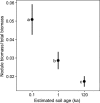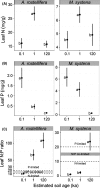Shifts in symbiotic associations in plants capable of forming multiple root symbioses across a long-term soil chronosequence
- PMID: 27066229
- PMCID: PMC4782245
- DOI: 10.1002/ece3.2000
Shifts in symbiotic associations in plants capable of forming multiple root symbioses across a long-term soil chronosequence
Abstract
Changes in soil nutrient availability during long-term ecosystem development influence the relative abundances of plant species with different nutrient-acquisition strategies. These changes in strategies are observed at the community level, but whether they also occur within individual species remains unknown. Plant species forming multiple root symbioses with arbuscular mycorrhizal (AM) fungi, ectomycorrhizal (ECM) fungi, and nitrogen-(N) fixing microorganisms provide valuable model systems to examine edaphic controls on symbioses related to nutrient acquisition, while simultaneously controlling for plant host identity. We grew two co-occurring species, Acacia rostellifera (N2-fixing and dual AM and ECM symbioses) and Melaleuca systena (AM and ECM dual symbioses), in three soils of contrasting ages (c. 0.1, 1, and 120 ka) collected along a long-term dune chronosequence in southwestern Australia. The soils differ in the type and strength of nutrient limitation, with primary productivity being limited by N (0.1 ka), co-limited by N and phosphorus (P) (1 ka), and by P (120 ka). We hypothesized that (i) within-species root colonization shifts from AM to ECM with increasing soil age, and that (ii) nodulation declines with increasing soil age, reflecting the shift from N to P limitation along the chronosequence. In both species, we observed a shift from AM to ECM root colonization with increasing soil age. In addition, nodulation in A. rostellifera declined with increasing soil age, consistent with a shift from N to P limitation. Shifts from AM to ECM root colonization reflect strengthening P limitation and an increasing proportion of total soil P in organic forms in older soils. This might occur because ECM fungi can access organic P via extracellular phosphatases, while AM fungi do not use organic P. Our results show that plants can shift their resource allocation to different root symbionts depending on nutrient availability during ecosystem development.
Keywords: Arbuscular mycorrhizal fungi; chronosequence; ectomycorrhizal fungi; nitrogen fixation; pedogenesis; phosphorus; rhizobia.
Figures





References
-
- Abbott, L. K. , Robson A. D., and De Boer G.. 1984. The effect of phosphorus on the formation of hyphae in soil by the vesicular‐arbuscular mycorrhial fungus, Glomus fasciculatum . New Phytologist 97:437–446.
-
- Adams, F. , Reddell P., Webb M. J., and Shipton W. A.. 2006. Arbuscular mycorrhizas and ectomycorrhizas on Eucalyptus grandis (Myrtaceae) trees and seedlings in native forests of tropical north‐eastern Australia. Aust. J. Bot. 54:271–281.
-
- Aggangan, N. S. , Dell B., and Malajczuk N.. 1996. Effects of soil pH on the ectomycorrhizal response of Eucalyptus urophylla seedlings. New Phytologist 134:539–546.
-
- André, S. , Neyra M., and Duponnois R.. 2003. Arbuscular mycorrhizal symbiosis changes the colonization pattern of Acacia tortilis spp. Raddiana rhizosphere by two strains of rhizobia. Microb. Ecol. 45:137–144. - PubMed
-
- Antibus, R. K. , Sinsabaugh R. L., and Linkins A. E.. 1992. Phosphatase activities and phosphorus uptake from inositol phosphate by ectomycorrhizal fungi. Can. J. Bot. 70:794–801.
LinkOut - more resources
Full Text Sources
Other Literature Sources

